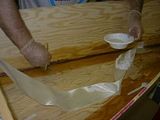
(Click to Enlarge)
Once I was happy that everything was as close to "aligned" as it was going to be, I began the Epoxy. Note the duct tape being used to pull the panels into symmetry.
Bare wood absorbs epoxy, so the joints are coated with plain resin before the fillets are applied. Once spread out thin enough, there is more than enough time to work the fillets into the joint before the epoxy hardens, about 3-4 hours. If it cures, care must be taken to ensure any amine blush is removed prior to applying the fillets.
























